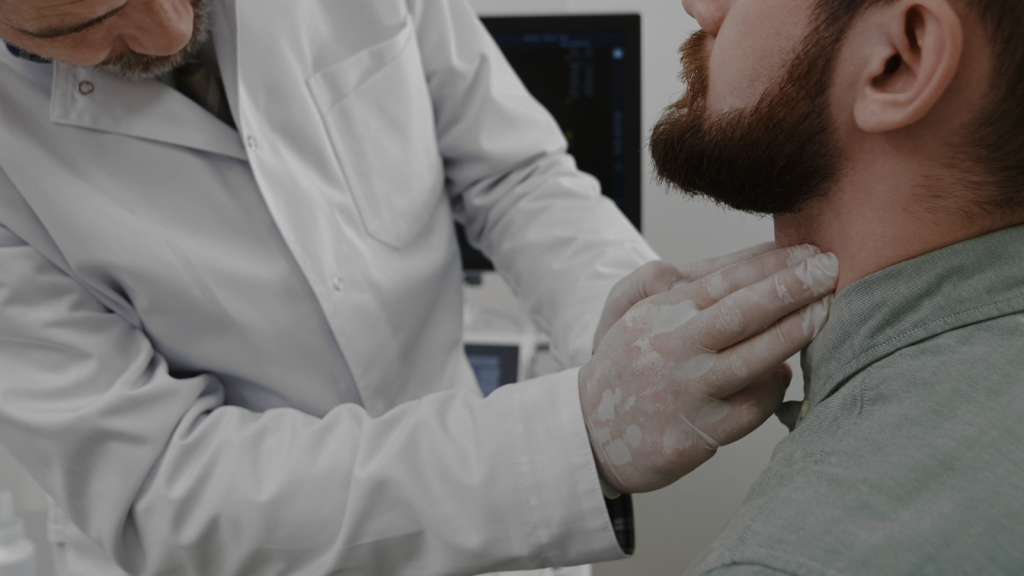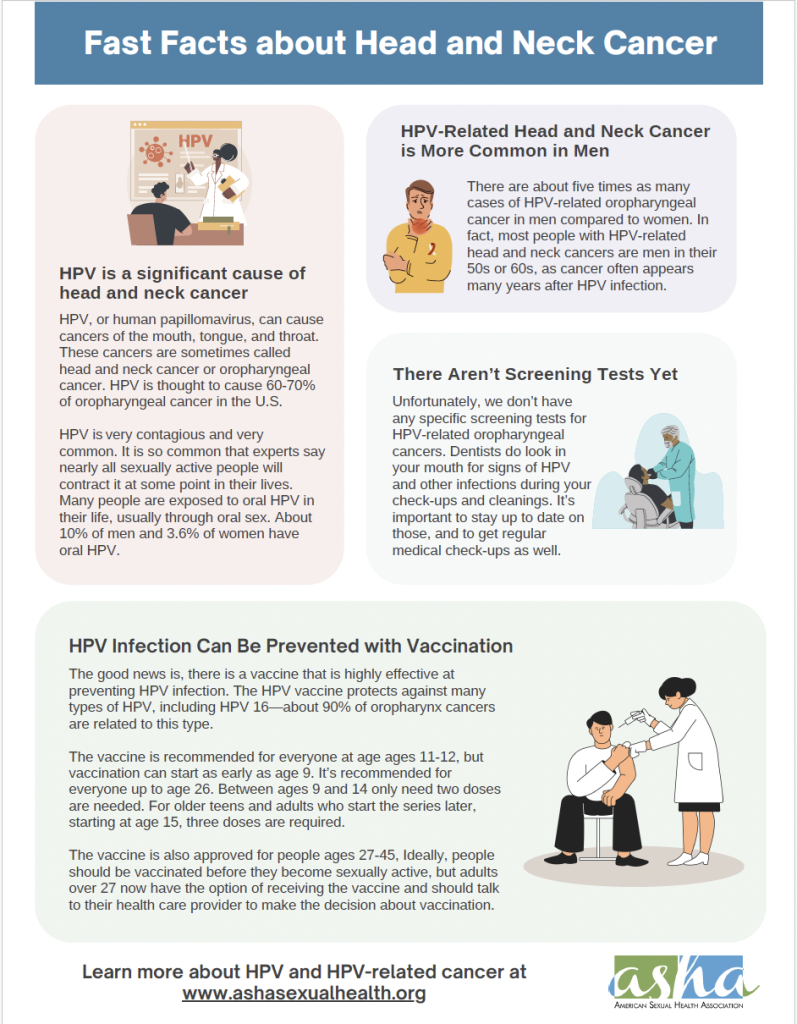Michael Moore, MD, is the Chief of the Division of Head and Neck Surgery at the Indiana University School of Medicine Department of Otolaryngology. He specializes in cancer removal and reconstructive surgery and works as a part of multidisciplinary team that manages treatment for head and neck cancer patients. Dr. Moore has also served as the Chair of the Cancer Prevention Service of the American Head and Neck Society (AHNS), a member of the American Cancer Society HPV Vaccination Roundtable, and as President of the Board of the Head and Neck Cancer Alliance.
ASHA recently sat down with Dr. Moore to ask about head and neck cancers caused by HPV.
What are head and neck cancers? Are they all caused by HPV?
Head and neck cancer is just a general term to describe any malignant tumors that start anywhere above the collarbone and below the brain. They can be everything from skin cancers to mouth and throat cancers to those that affect the back of the throat or voice box. They also include salivary cancer and thyroid cancers.
The primary risk factors for head and neck cancer historically were tobacco and alcohol use because they are carcinogens that affected the areas they came in contact with like the lining of the mouth and throat. Those have been slowly going down over the years because education and tobacco taxes means there’s less and less smoking and the result is less and less tobacco-related cancers which is great.
The only area where incidence of head and neck cancer is going up is in what we call oropharyngeal cancers. These are usually at the back of the throat and are primarily due to HPV infection.
Are these cancers in spots that you can see inside your own mouth?
No. These cancers usually occur at the base of the tongue or in the tissue around the tonsils. If you’re looking at the back of your mouth, it’s kind of around the corner where you can’t see. This tissue has little pits in them that filter stuff as part of your immune system and those pits can act as a reservoir. When you get a viral infection, it can hang out at the bottom of those pits which makes that area more susceptible for cancers.
Are these cancers caused by the same types of HPV that cause cervical cancer?
Yes. HPV 16—which is also the cause of most cervical cancer—is the primary driver for head and neck cancer related to HPV. About 90% of the oropharynx cancers are related to this type.
Does that mean that the vaccine—which protects against 9 types of HPV including 16—will protect against oropharyngeal cancers as well?
We think so and there has been some research to support this. We know that it protects against high-risk HPV infection which is great. The challenge in determining how well the vaccine works is that there is a long latency period between infection and oropharyngeal cancer. Maybe even 20 or 30 years.
And we don’t have any tests for precancerous legions like we do for cervical cancer. The vaccine hasn’t been around for that long. Most of the people who get oropharyngeal cancers are in their 50s and probably got exposed when they were adolescents or young adults. It’s going to take some years before we’re able to show that the vaccine is working on a large scale.
Would you still recommend the vaccine to most people?
Yes. The protective effect of reducing persistent infection is important, and I think studies will ultimately find that it reduces the risk of head and neck cancers as well. I’m not a population person but I also think vaccinating more people will have a kind of overall protective effect. If infection rates overall go down that will have downstream benefits for cancer development.
You mentioned that HPV infection can hide out in the throat for years before become cancer, are there any tests that can look for this? How does someone find out they have head and neck cancer?
There are no screening tests yet. There are some new blood tests that look for what’s called the HPV cell free DNA. These aren’t screening tests; they’re used to get more information when we’re planning cancer treatment. It’s possible that they will advance at some point to something similar to a PSA test for prostate cancers but not yet.
There are also not always symptoms. In other types of head and neck cancer, like those caused by tobacco, a person might have difficulty swallowing or persistent throat pain because the primary tumor is aggressive. But with cancer of the oropharynx caused by HIV, the primary tumor is usually very small. Sometimes it’s so small, that I can’t even see it when I look down someone’s throat.
The most common presenting symptom for a person with HPV-related throat cancer is a neck mass, like a lump in the neck. That’s actually a lymph node metastasis already which means the cancer has already spread. I’m an oncologist so I see people who have been diagnosed with cancer, when they get to me their main symptoms other than the lymph node may be a change in their voice, difficulty swallowing, or throat pain, often only on one side. Sometimes they have pain in their ear that is actually referred pain from their throat, and they may be coughing up blood.
What are the treatments for HPV-related head and neck cancers?
A lot of it depends on the extent of the tumor and where it is. There are two ways to approach it. One is to start with surgery and take out the primary tumor and possibly some lymph nodes. And then depending on how early the cancer was caught we might just monitor it closely or we might decide to do radiation and/or chemotherapy to reduce the chance that there’s some microscopic cancer that would grow back. There’s also the non-surgical option that just uses radiation for early disease and chemotherapy for advanced disease.
These are some of the longest conversations I have with my patients because they’re very different. With surgery you may have more upfront side effects like pain and trouble swallowing until your throat is healed. With higher doses of radiation, you may get dryness of the mouth or damage to the taste bud. These are the factors patients have to weigh.
What are the survival rates for head and neck cancers?
As long as it’s not spread to other parts of the body, survival rates for HPV-related head and neck cancer can be between 80% and 90% or even higher. This is much better than survival rates for head and neck cancers caused by smoking.
Do people with HPV-related cancers usually get the initial HPV infection from oral sex?
Most likely yes. There have been studies that show that an increased number of oral sex partners and early sexual debut are risk factors for developing HPV-related oropharynx cancer. But I think there’s a lot that we still don’t know.
It’s about four to one, men to women as far as who gets oropharynx cancer, but men who have sex with men are not necessarily at dramatically increased risk. An increased viral concentration of HPV in vaginal secretions might explain why the heterosexual population can be affected significantly by this. The immune system might also play an underlying role, but we don’t know all of it yet.
Are most of your patients aware of the connection between cancer, HPV, and oral sex when their diagnosed?
They’ve usually heard of the virus. Most of them have heard of it in regards to cervical cancer but many of them have not heard of it in the context of throat cancer.
Do you think the connection to oral sex increase stigma around these cancers?
With head and neck cancers there is stigma to begin with because many people think it’s related to tobacco use and patients think it was their fault because they smoked. I do think there’s also some stigma around the idea of promiscuity because we still have a lot of societal stigma around sex unfortunately.
I think people are also worried when they’re talking to their spouse, I try to stress that it’s impossible to say where HPV came from, or which partner it came from.
I also try to stress to my patients that the vast majority of adults have been exposed to HPV and that throat cancer is now the most common HPV-related cancer in America. It is close to two times as common as cervical cancer now.
Is that because of the vaccine or widespread Pap and HPV testing?
The biggest thing is that many cases of cervical cancer are caught in the precancerous stage. The vaccine is also good but there is a bit of a lag before we’ll see that. For head and neck cancer it’s really a combination of not having good screening tests, males getting the vaccine less frequently, and a longer latent period before cancers develop. So even if vaccination in the younger groups is happening, there is a group of people over the next 20 or 30 years who will be developing these cancers because they have already gotten HPV.
I think our Holy Grail for reducing these cancers is going to be finding a screening test that can be widely used.









